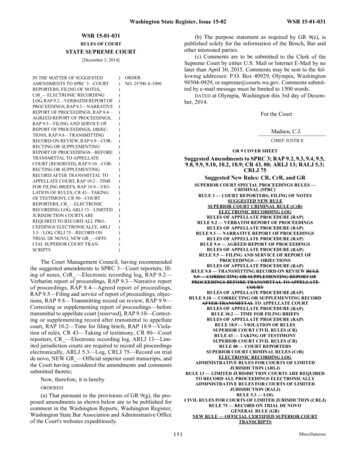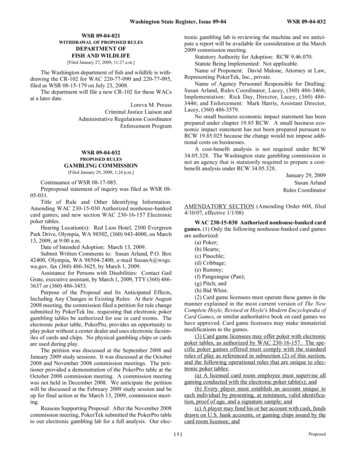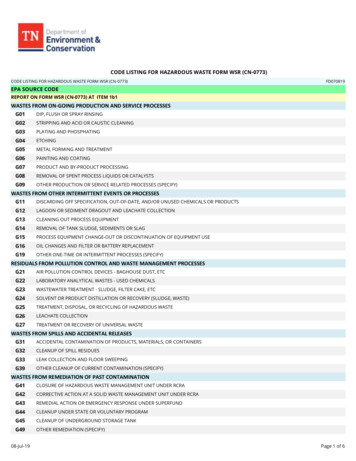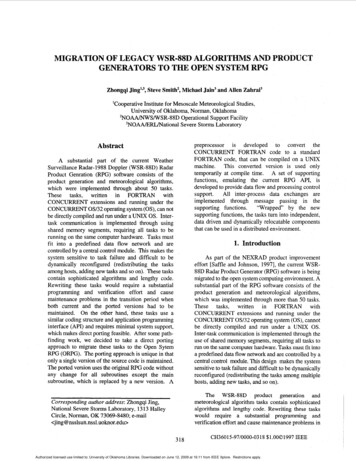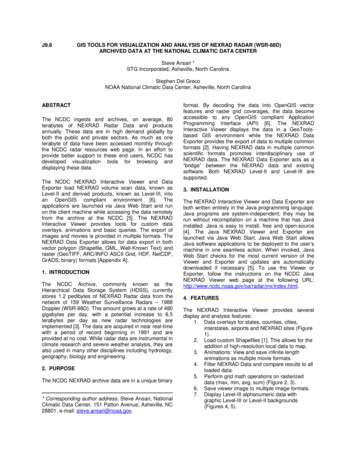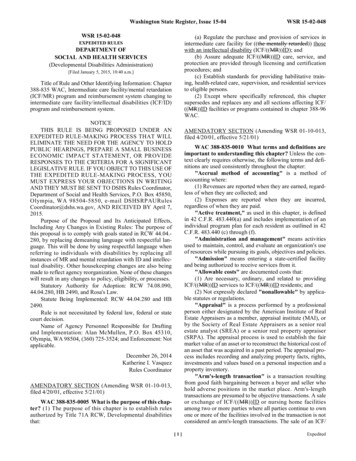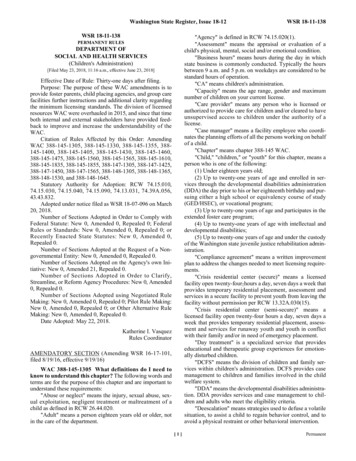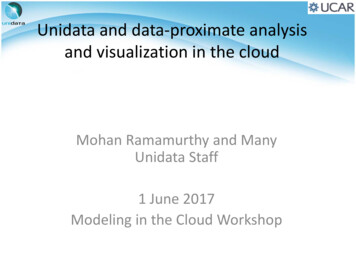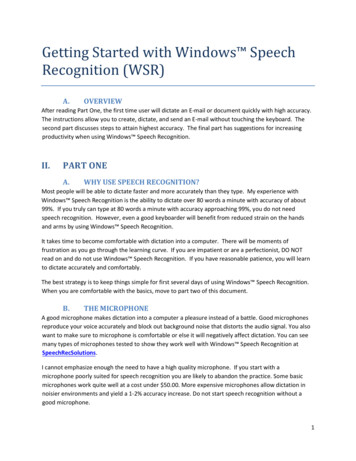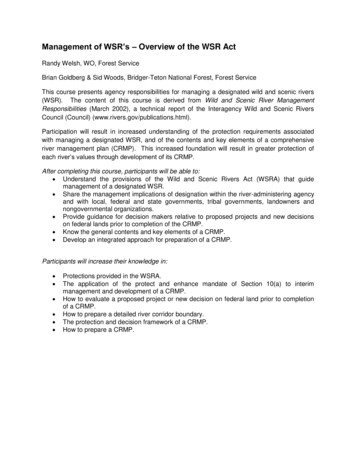
Transcription
Management of WSR’s – Overview of the WSR ActRandy Welsh, WO, Forest ServiceBrian Goldberg & Sid Woods, Bridger-Teton National Forest, Forest ServiceThis course presents agency responsibilities for managing a designated wild and scenic rivers(WSR). The content of this course is derived from Wild and Scenic River ManagementResponsibilities (March 2002), a technical report of the Interagency Wild and Scenic RiversCouncil (Council) (www.rivers.gov/publications.html).Participation will result in increased understanding of the protection requirements associatedwith managing a designated WSR, and of the contents and key elements of a comprehensiveriver management plan (CRMP). This increased foundation will result in greater protection ofeach river’s values through development of its CRMP.After completing this course, participants will be able to: Understand the provisions of the Wild and Scenic Rivers Act (WSRA) that guidemanagement of a designated WSR. Share the management implications of designation within the river-administering agencyand with local, federal and state governments, tribal governments, landowners andnongovernmental organizations. Provide guidance for decision makers relative to proposed projects and new decisionson federal lands prior to completion of the CRMP. Know the general contents and key elements of a CRMP. Develop an integrated approach for preparation of a CRMP.Participants will increase their knowledge in: Protections provided in the WSRA.The application of the protect and enhance mandate of Section 10(a) to interimmanagement and development of a CRMP.How to evaluate a proposed project or new decision on federal land prior to completionof a CRMP.How to prepare a detailed river corridor boundary.The protection and decision framework of a CRMP.How to prepare a CRMP.
Managing Utah’s First Wild and Scenic RiverTracy Atkins, PE, AICP,1 NPS, Ericka Pilcher2, NPS, and Kezia Nielsen3, NPS1. National Park Service , Project Manager, Denver Service Center, Planning Division, Denver ,Colorado, USA, Tracy atkins@nps.gov2. National Park Service , Visitor Use Planner, Denver Service Center, Planning Division, Denver,Colorado, USA, Ericka pilcher@nps.gov3. Kezia Nielsen, Environmental Protection Specialist, Zion National Park, Utah, USA,Kezia nielsen@nps.govThis session will describe the Wild and Scenic River planning framework used for thedevelopment of the Comprehensive River Management Plan for the Virgin River at ZionNational Park and adjacent BLM Wilderness. NPS has developed a process that includesdefining outstandingly remarkable values (ORVs), establishing goals and objectives forprotecting river values, conducting boundary delineation, addressing development of lands andfacilities, addressing visitor use management and capacity, evaluating water resource projectsand instream flows, and establishing a monitoring strategy. This planning effort included riversegments with very diverse visitation and management objectives – from highly developedfrontcountry recreational segments to wild segments in designated Wilderness.Thispresentation will share outcomes of the planning process as well as lessons learned and ongoing monitoring and planning efforts.Key Learning Objectives:1) Understanding the planning framework for Wild and Scenic Rivers2) Best practices for planning and managing use on Wild and Scenic Rivers3) Strategies for managing a variety of river segments from frontcountry to Wilderness123
Wild and Scenic River Outstandingly Remarkable Value Identificationand Assessment using Georeferenced VideomappingAyers, Paul 11. Biosystems Engineering, University of Tennessee, Knoxville, TN 37830. ayers@utk.eduAbstractGPS-based river videomapping has been used to continuously map river systems at theNational Park Service (NPS) Obed (45 miles) and Wekiva (12 miles) Wild and Scenic Rivers(WSR). River videomapping consists of continuously acquiring georeferenced video and riverphysical characteristics of river systems. Physical river features such as river width, depth,rugosity and sinuosity have been mapped in ArcGIS. In addition, substrate, river characteristic(pool, riffle, run), embeddedness and river infrastructure have been determined continuously.From these features, locations of wildlife habitat (including optimum endangered aquaticspecies habitat) and Outstandingly Remarkable Values (ORV) have be determined. ORV’s andhuman intrusion infrastructure (houses, docks, bridges, etc.) have been mapped at the WekivaWSR. Dock density plots and associated images have been incorporated into the ArcGIS maps.Using the technology, “wild”, “scenic” and “recreational” ORV’s can be identified and mapped.The georeferenced video database of the Wild and Scenic River provides a snapshot of theexisting ORV conditions that need to be mapped, monitored and managed. The video can bereviewed to detect river condition changes as impacts occur.
Assessing Complex Issues of Resource Protection and Allocation;Weighing Science, Management, Politics, and Public Opinion. A CaseStudy on Wild and Scenic Rivers in Grand Canyon National Park.Cassie Thomas1, Linda Jalbert2, Bill Hansen3, & Joel Barnes41. National Park Service, Grand Canyon, AZ, USA, linda jalbert@nps.gov2. National Park Service, Ft. Collins, CO, USA , bill hansen@nps.gov3. National Park Service, Anchorage, AK, USA, cassie thomas@nps.gov4. Prescott College, Prescott, AZ, USA, jbarnes@prescott.eduThis training workshop is designed to help public land managers and conservation advocatesdevelop strategies to better understand and evaluate input from science, management, politics,and public opinion. Short presentations from the panel will set the context for structured smallgroup work that generates practical working strategies. Using wild and scenic river designationin Grand Canyon National Park as our case study, we will explore the challenges of complexissues of resource protection and allocation. The Colorado River and its tributaries in andaround the Grand Canyon have yet to be honored with WSR designation. This comes as asurprise to many; even those actively involved in river conservation and public landsmanagement. One could easily assume that the spectacular Colorado River and its tributaries inGrand Canyon are shining gems of the National Wild and Scenic River System. Grand CanyonNational Park is currently revising its Backcountry Management Plan, but thus far in theplanning process, WSRs have been identified as “beyond the scope” of this plan. This is thesame stance the park took on WSRs in the Colorado River Management Plan back in 2006.This situation begs the question, “if not now, when?” in regards to WSRs in GCNP. In thisworkshop we will explore the implications of WSR designation for the Colorado River and itstributaries in and adjacent to GCNP from ecological, management, and biopolitical perspectives.
Understanding and Managing Visitor Use on the Virgin River, UtahEricka Pilcher,1 NPS, Tracy Atkins, PE, AICP 2, NPS, and Kezia Nielsen3, NPS1. National Park Service , Denver Service Center, Planning Division, Denver, Colorado, USA,Ericka pilcher@nps.gov2. National Park Service , Denver Service Center, Planning Division, Denver , Colorado, USA,Tracy atkins@nps.gov3. Kezia Nielsen, Environmental Protection Specialist, Zion National Park, Utah, USA,Kezia nielsen@nps.govThis session will describe lessons learned while addressing visitor use management and visitorcapacity during the development of the Comprehensive River Management Plan for the VirginRiver at Zion National Park and adjacent BLM Wilderness. This plan used a proactive andadaptive process of planning for and managing characteristics of visitor use and its physical andsocial setting. The process provides a variety of strategies and tools to sustain desiredconditions for river values and provides the framework within which visitor capacity should beaddressed when necessary. The plan followed guidance from both the Interagency Wild andScenic Rivers Coordination Council (IWSRCC) and the Interagency Visitor Use ManagementCouncil (IVUMC). Updates on the work of the IVUMC will be provided during this session. TheIVUMC collaborated with the IWSRCC on their guidebook for “Addressing User Capacities inComprehensive River Management Plans”. The IVUMC is also working to complete “how-to”guidebooks for the visitor use management framework, visitor capacity, and indicators andthresholds. Progress on these topics will be discussed in the context of the Virgin River planningeffort.
Wild and Scenic River Study Process – How to complete a WSR StudyCassie Thomas and Jim MacCartney, National Park ServiceThis course presents an introduction to complete a the Wild and Scenic Rivers Act (WSRA)Study Process for eligible or suitable river segments.The content of this course is derivedfrom Wild and Scenic Rivers Act: Wild and Scenic River Study Process, a technical report of theInteragency Wild and Scenic Rivers Council (Council) (www.rivers.gov/publications.html).Participation will result in improvements in future applications of the Wild and Scenic RiverStudy process, for both eligible and suitable river segments, based on increased knowledge ofits intent, content and procedures.After completing this course, participants will be able to: Apply the correct study methodology for a Wild and Scenic River study. Develop an integrated approach with appropriate interdisciplinary team members for thestudy process. Conduct the study, including public involvement. Share information with landowners, local and state governments, and nongovernmentalorganizations.Participants will increase their knowledge in: The Wild and Scenic River study process requirements of the WSRA. The sources of information for rivers to consider in the study process. The differences between eligible and suitable river segments. The role of ORV’s in the study process. The differences in WSR classification and how to apply them to study segments. The requirements for interim management direction for eligible and suitable riversegments.
Sustainable Recreation: Fossil Creek Wild and Scenic River PlanningFrancisco Valenzuela, Director of Recreation, Heritage, and Wilderness, Southwestern. USDAForest Service, Albuquerque, New Mexico, U.S.A., fvalenzuela@fs.fed.usThe goal is to create a community during the planning process the helps assure the neededsupport to sustain the programs, facilities and river ecosystem. We are engaging the nextgeneration of river professionals by including new employees in the planning process.ABSTRACTThe Forest Service is on a journey to transition the agency’s Recreation program towardsustainability and this paradigm change is referred to as “Sustainable Recreation”. Thedevelopment of the Comprehensive River Management Plan was the first opportunity to use thisnew framework for a Wild and Scenic River. It is the Forest Service’s premise that the goal ofsustainable recreation creates greater lasting public benefits and facilitates the emergence ofmore self-organizing and resilient social-ecological systems. While the situation containedmany complex and so called wicked problems the use of sustainability driven collaborativemethods lead toward the creation of a future that is both more desirable and sustainable andbrings people together. The presentation will also demonstrate new techniques that quicklyhelp develop alternatives, address the outstanding resource values and potentially conflictinguses.The goal of this presentation is to promote the use of state of the art sustainability science to theplanning management of rivers. Plans must create futures that are resilient to changingecological conditions and social conditions. The planning process is an opportunity for learningand a cycle of learning, innovation and adaptations in the end protects the ecosystem servicesand provides for intergenerational equity by ensuring that the program enhances our capabilitiesto provide benefits for future generationsThe key points include: That sustainable recreation will be the guiding framework for the 21st century rivermanagers.That sustainable recreation is about the quality of life, how to develop it and how tosustain it.That better understanding the dynamics of human-environmental systems will helpcreate new and better possibilities and will bring together social and natural sciences.That by appreciating the many world views and encouraging group learning collaborationbecomes far more possible.That collaboration and community building is the key to the sustainability of rivers.
Section 7 Determinations – How to complete a Section 7Randy Welsh & Steve Chesterton, WO, Forest ServiceThis course presents an introduction to and how to complete a Section 7 Determination for theWild and Scenic Rivers Act (WSRA).The content of this course is derived from Wild andScenic Rivers Act: Section 7, a technical report of the Interagency Wild and Scenic RiversCouncil (Council) (www.rivers.gov/publications.html).Participation will result in improvements in future applications of Section 7, based on increasedknowledge of its intent, content and procedures.After completing this course, participants will be able to: Apply appropriate evaluative standards. Develop an integrated approach with appropriate interdisciplinary team members. Conduct an analysis adequate to support the determination. Provide early consultation/collaboration to federal assisting agency. Share information with landowners, local and state governments, and nongovernmentalorganizations.Participants will increase their knowledge in: What a water resources project is under Section 7 of the WSRA.How to apply Section 7 to state-administered, federally designated rivers;congressionally designated rivers; and congressionally authorized study rivers.Definitions.Roles of the involved agencies.Evaluation standards for a designated river.Evaluation standards for a congressionally authorized study river.Evaluation procedures.The timing of a Section 7 analysis and determination, and the responsible official.Riverine stewardship.
1. Biosystems Engineering, University of Tennessee, Knoxville, TN 37830. ayers@utk.edu Abstract GPS-based river videomapping has been used to continuously map river systems at the National Park Service (NPS) Obed (45 miles) and Wekiva (12 miles) Wild and Scenic Rivers (WSR).
